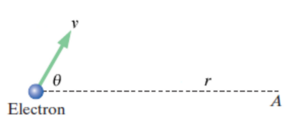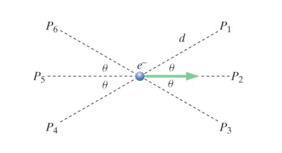Moving Point Charge: Difference between revisions
No edit summary |
|||
| Line 87: | Line 87: | ||
[[Biot-Savart Law for Currents]] | [[Biot-Savart Law for Currents]] | ||
[[Magnetic Force]] | |||
[[Right-Hand Rule]] | |||
==References== | ==References== | ||
Revision as of 23:07, 3 December 2015
This page covers the method of calculating the magnetic field from a moving point charge, derived from the Biot-Savart Law for magnetic fields.
The Main Idea
A Mathematical Model
The magnetic field of a moving point charge can be found using a derivation of the Biot-Savart Law for magnetic fields.
With this equation for the magnetic field given some current carrying object, we can rewrite Idl in terms of velocity in order to relate the velocity of the moving particle to the magnetic field at an observation location a distance r from this particle.
With this substitution, the final formula comes out to be:
where q is the charge of the particle, v is the velocity of the moving particle, and r is the distance from the observation location to the moving particle.
Examples
Simple
At a particular instant, a proton at the origin has velocity < 4e4, -3e4, 0> m/s. Calculate the magnetic field at location < 0.03, 0.06, 0 > m, due to the moving proton.
Solution:
1. The first we need to do is find r hat. Given the vector <0.03, 0.06, 0>, we can calculate the normalized r hat vector to be < 0.447, 0.894, 0 >.
2. Once we have both the velocity and r hat vectors, we can take the cross product of these two as the equation  tells us to do.
Crossing these two, we get < 0, 0, 49200>
tells us to do.
Crossing these two, we get < 0, 0, 49200>
3. The magnetic field will be this cross product multiplied by the charge of the proton [math]\displaystyle{ 1.6*10^{-19} }[/math] and divided by the magnitude of r squared. Don't forget to also multiply this by [math]\displaystyle{ \mu_0 }[/math] or [math]\displaystyle{ 10^{-7} }[/math].
The final answer will be [math]\displaystyle{ \lt 0, 0, 1.75*10^{-19}\gt }[/math] T
Medium
The electron in the figure below is traveling with a speed of [math]\displaystyle{ v = 4*10^6 }[/math]m/s. What is the magnitude of the magnetic field at location A if r = [math]\displaystyle{ 7*10^{-10} }[/math]m and [math]\displaystyle{ \theta=57 }[/math] degrees
Solution:
1. First split up the velocity in to its x and y components by multiplying the given velocity by cos(57) and sin(57) for x and y respectively.
2. Find r hat and take the cross product of your new velocity vector with r hat.
3. Multiply this by the magnitude of the charge for an electron, as well as by [math]\displaystyle{ \mu_0 }[/math] and then divide this by [math]\displaystyle{ r^2 }[/math]
The final answer will be 0.11 T
Difficult
An electron is moving horizontally to the right with speed [math]\displaystyle{ 6*10^6 }[/math] m/s. What is the magnetic field due to this moving electron at the indicated locations in the figure? Each location is d = 7 cm from the electron, and the angle θ = 34°. Give both magnitude and direction of the magnetic field at locations 1, 2 and 3.
Solution:
1. Find the r vector for each location, using [math]\displaystyle{ \theta }[/math] to calculate the x and y components
2. For each r vector, take the cross product v X r where the v is given.
3. Multiply each respective cross product by the magnitude of charge and [math]\displaystyle{ mu_0 }[/math].
4. In order to find the direction of the magnetic fields, use the Right Hand Rule. One way to do this is to point your thumb in the direction of the velocity, your pointer finger in the direction of r hat, and look which way your palm is facing in order to find the direction of the magnetic field.
At location P2 and P5 the magnetic field will be zero. P1 will be into the page, P3 will be out of the page, P4 will be out of the page, and P6 will be into the page
Connectedness
A single moving point charge represents the most simple situation of charges moving in space to produce a magnetic field. In reality, this situation rarely occurs, however understanding how a single moving point charge interacts to produce a field will allow you to understand how sets of moving charges produce a field in space as well.
History
The history of the Biot Savart law and its discovery can be found at the Biot-Savart Law.
See also
Biot-Savart Law for Currents Magnetic Force Right-Hand Rule
References
http://maxwell.ucdavis.edu/~electro/magnetic_field/pointcharge.html



